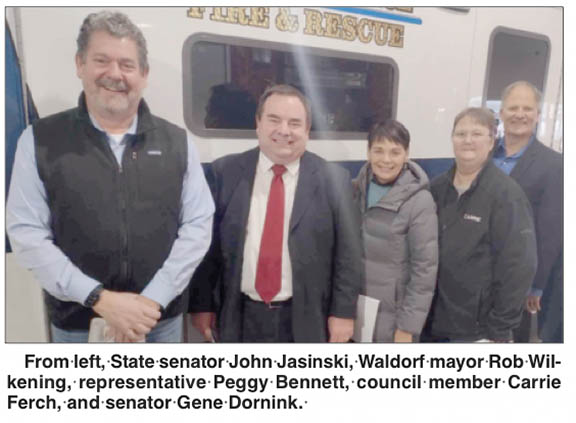 By ELI LUTGENS
By ELI LUTGENS
Publisher/Editor
The Minnesota State Senate Bonding Committee visited Waldorf November 28 to discuss potentially providing nearly $4 million for various city projects.
The stop was one of many statewide for the bonding committee, which allocated 20 minutes per visit. While on site, senators acquire information to help determine where to dedicate funds from the state’s upcoming bonding. Every two years legislators pass a statewide bonding bill which allocates money for various projects. In 2022, more than $1.5 billion was allocated. The rebuild of Tink Larson Field in Waseca, for example, was made possible when the construction received last-minute placement on the project list.
The city of Waldorf is seeking $7.4 million from state and federal sources to build a new public safety building and complete its “Phase 2 project.”
The Phase 1 project amounted to $15 million over three years and included replacing city storm sewer, sanitary sewer and water lines, refurbishing the water tower, building a new sanitary pond system and drainfield, and repairing or replacing some roadways and sidewalks.
While the projects funded by state and federal money were underway, the city was forced to deal with auxiliary complications. The city’s water treatment plant failed, causing the city to come up with an emergency plan to rebuild the treatment filtration system. According to a presentation Waldorf mayor Rob Wilkening showed senators during their visit, the city found a creative solution which included opening a wall of the treatment plant to remove and replace the failed equipment. Wilkening emphasized to senators that the city worked resourcefully to solve this sudden complication. He also pointed out the city used its own financing to cover the unexpected $350,000 cost, all while the bonding bill projects continued uninterrupted.
Wilkening also told senators of a complication discovered after city storm and sewer lines were replaced. It was discovered that many residential lines were experiencing “inflow and infiltration” (INI), allowing an unacceptable amount of water to leak into them and add to the burden on the water treatment plant, thus continuing fines imposed by the Minnesota Pollution Control Agency. To solve that problem, Wilkening reported, the city secured a $750,000 loan for residents and businesses to correct their problems. The city worked with the MNPCA to be one of the first cities in the state to design these creative low-interest loans to assist property owners in getting repairs.
Wilkening’s presentation and summary were apparently meant to assure visiting senators the city had made good use of the “phase 1” funds, and could be trusted to do the same with additional money.
What will Phase 2 include?
For the 2024 bonding bill, the city of Waldorf is requesting $3.7 million. The proposed project includes additional street improvements; a lift station to allow the city’s sanitary system to accommodate future businesses along State Hwy 83; new infrastructure to accommodate housing; and also public park improvements.
Safety Building
Also part of the 2024 request is a new Waldorf Safety Building.
Waldorf Fire and Rescue services a 72-square-mile radius and approximately 1,300 residents.
“With the growth of neighboring cities, the demand for growth is increasing,” Mayor Wilkening wrote in the city’s proposal. “A new fire and rescue facility would improve the quality of service in the region by reducing response times, increasing efficiency and lowering insurance rates. In addition, this would help to recruit and retain firefighters.”
The current facility creates many hazards to the health and well-being of the 21 on-call volunteer firefighters in Waldorf. Simply explained, the current fire hall is not fully compliant with state and federal safety standards. A new safety building would meet relevant requirements
How did the visit go?
Waldorf Mayor Rob Wilkening said the meeting went well. He and others intend to set appointments with various senators and congressmen at the capital to talk further.
Wilkening commented that one of the committee members asked in a surprised tone how a town Waldorf’s size received $15 million for funding in Phase 1. “You just have to know how to apply and write grant applications,” Wilkening answered.
Wilkening said Julie Rosen and he had once worked together to plan Phase 2, but then redistricting happened and Waldorf has missed out ever since.
“Rural Minnesota is at a disadvantage for this kind of funding,” Wilkening said. “Larger cities have a larger tax base and more say.”
Asked what would happen if Wadorf doesn’t receive the bonding funds, Wilkening said the intended projects would have to be delayed.
“We cannot afford it as a city,” Wilkening said. “I’m optimistic that we’ll get one of the projects included in the bonding bill. If not, then we’ll just continue on. All you can do is try and not give up.”
Wilkening believes Waldorf is growing, citing the need for housing. “Every lot, every house is full, nothing is available. We need to establish housing… We need to be sustainable. That is the key.”
